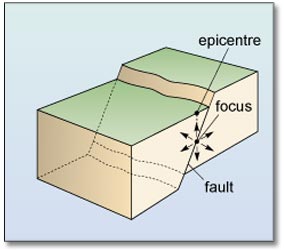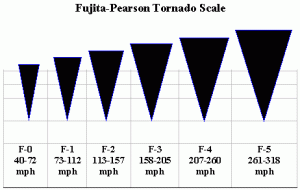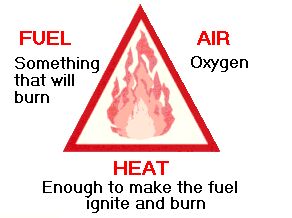Natural disasters
Tsunami
A Tsunami is a series of huge waves that strike a coast. The waves are formed when a massive amount of water is displaced due to an under sea disturbance. Such as; Earthquakes, Volcanic Eruptions, Meteorites or even nuclear weapon testing, as well with the movement of tectonic plates, from where the Tsunami starts it sends waves in all directions.
“Tsunamis race across the sea at up to 500 miles (805 kilometers) an hour—about as fast as a jet airplane. At that pace they can cross the entire expanse of the Pacific Ocean in less than a day. And their long wavelengths mean they lose very little energy along the way.” (National Geographic, 2015), they also can get up to 100 feet tall, in some cases larger. The shallower the water the greater the height of the wave.
“All tsunamis are potentially dangerous, even though they may not damage every coastline they strike. A tsunami can strike anywhere along most of the U.S. coastline. The most destructive tsunamis have occurred along the coasts of California, Oregon, Washington, Alaska, and Hawaii.” (ITIC, 2015), they also destroy ecosystems.
“Most tsunamis, about 80 percent, happen within the Pacific Ocean’s “Ring of Fire,” a geologically active area where tectonic shifts make volcanoes and earthquakes common.” (National Geographic, 2015)
Earthquakes
A earthquake is when the earth shakes or vibrates violently. Earthquakes are caused when tectonic plates are shifting or a sudden break along the fault line, a fault line is where two tectonic plates meet. Once this happens they are seismic waves make the ground shake. Adding on to this, “earthquakes are the rumblings, shaking or rolling of the earth's surface. It is usually what happens when two blocks of the earth suddenly slip past one another(Tectonic plates), or break apart from each other as a result of tension caused by prolonged energy build up” (EschoolToday, 2015)

There are six levels of tornadoes. The first level Of tornadoes is an F0. An F0 consist of; Having a wind speed from 40-72 mph, It causes light damage, and knocks over small trees and branches off big ones. The Second level is an F1. An F1 consist of; A wind speed from 73-112 mph, Causes moderate damage, breaks tiles of roofs, and cars and trailers are pushed over. The Third Level is an F2. An F2 consists of; Wind speeds from 113-157 mph, causes considerate damage, roofs get torn off, big trees are knocked down, cars are lifted, mobile homes are destroyed. The fourth level is an F3. An f3 consists of; wind speeds from 158-206 mph, causes severe damage, roofs torn off, trains are turned over. The The fifth level is an F4. an F4 consists of; have a wind speed from 207-260 mph, causes catastrophic damage, well constructed structures are are ground level, poor structured homes are blown away. The sixth level is a F5. An F5 consists of; have a wind speed of 261-318 mph, causes catastrophic damage, few or very little structures standing, cars fly for miles.

Volcanoes are a land form created by magma from the earths interior. Most volcanoes are formed near or even at plate boundaries. There are three different categories of volcanoes; active, dormant and extinct.

“As magma rises closer to the Earths surface the pressure decreases and the dissolved gases come out of solution to form bubbles. As the bubbles expand the magma is pushed into the volcanic vent until it breaks through weaknesses in the Earth's crust.” (Natural Hazards, 2015). The explosives potential of the volcano is dependent on the effervescence of the gases and the viscosity of the magma, and has a high gas effervescence and low viscosity cause the most explosive eruptions. In the world there are about 500 active volcanoes and about 50 of them erupt a year.
Volcanic hazards are the most dramatic and threatening out of all natural disasters. Explosive eruptions drastically alter land and water for tens of kilometers around a volcano, tiny liquid droplets of sulfuric acid erupted into the stratosphere can change our planet's climate temporarily, and corps are destroyed.
There are a variety of different volcanoes, Such as; A fissure Volcano, Volcano dome, Shield volcano,Cinder Cone Volcano and Caldera Volcano
A fissure volcano is a crack in the earth where the lava comes out. it has the hottest magma called basaltic.

There are three stages of earthquakes, which are; “Sometimes, there are smaller shocks that occur before (1st foreshock) and after (3rd aftershock) a main earthquake (2nd mainshock). Sometimes foreshocks are so big and scientists are unsure if it is the main shock. Foreshocks and aftershocks can occur for days, weeks and months of a main earthquake.” (EschoolToday, 2015) Earthquakes could cause other type of natural disasters such as; avalanches/ landslides, tsunamis, and Liquefaction
Tornadoes
A tornado is a violent rotating column of air that is in contact with both the surface of the earth and a cumulonimbus cloud. Tornadoes are formed when both high pressure and low pressure air interact. A low internal pressure draws in high pressure air to form the vortex and eventually the tornado. (Cumulonimbus cloud, A dense towering vertical cloud associated with thunderstorms and atmospheric unstable.)
“Tornadoes come in many shapes and sizes, but they are typically in the form of a visible condensation funnel, whose narrow end touches the earth and is often encircled by a cloud of debris and dust.” (Wikipedia,2015). Most tornadoes have a wind speed less than 110 per hour and are about 250 feet wide. The most extreme ones can get up to 300 miles per hour and can get up to 300 feet wide. They usually move from the southeast to the northeast but they are able to move in any direction. There are six levels of tornadoes. The first level Of tornadoes is an F0. An F0 consist of; Having a wind speed from 40-72 mph, It causes light damage, and knocks over small trees and branches off big ones. The Second level is an F1. An F1 consist of; A wind speed from 73-112 mph, Causes moderate damage, breaks tiles of roofs, and cars and trailers are pushed over. The Third Level is an F2. An F2 consists of; Wind speeds from 113-157 mph, causes considerate damage, roofs get torn off, big trees are knocked down, cars are lifted, mobile homes are destroyed. The fourth level is an F3. An f3 consists of; wind speeds from 158-206 mph, causes severe damage, roofs torn off, trains are turned over. The The fifth level is an F4. an F4 consists of; have a wind speed from 207-260 mph, causes catastrophic damage, well constructed structures are are ground level, poor structured homes are blown away. The sixth level is a F5. An F5 consists of; have a wind speed of 261-318 mph, causes catastrophic damage, few or very little structures standing, cars fly for miles.
Volcanoes
Volcanoes are a land form created by magma from the earths interior. Most volcanoes are formed near or even at plate boundaries. There are three different categories of volcanoes; active, dormant and extinct.
“As magma rises closer to the Earths surface the pressure decreases and the dissolved gases come out of solution to form bubbles. As the bubbles expand the magma is pushed into the volcanic vent until it breaks through weaknesses in the Earth's crust.” (Natural Hazards, 2015). The explosives potential of the volcano is dependent on the effervescence of the gases and the viscosity of the magma, and has a high gas effervescence and low viscosity cause the most explosive eruptions. In the world there are about 500 active volcanoes and about 50 of them erupt a year.
Volcanic hazards are the most dramatic and threatening out of all natural disasters. Explosive eruptions drastically alter land and water for tens of kilometers around a volcano, tiny liquid droplets of sulfuric acid erupted into the stratosphere can change our planet's climate temporarily, and corps are destroyed.
There are a variety of different volcanoes, Such as; A fissure Volcano, Volcano dome, Shield volcano,Cinder Cone Volcano and Caldera Volcano
A fissure volcano is a crack in the earth where the lava comes out. it has the hottest magma called basaltic.
Wildfires
A wildfire is a uncontrolled fire, fueled by natural vegetation. In Australia they are called bush fires and in North America they are called brush fires, wildfires are caused by many things such as; Lightning, burning campfires or cigarettes, hot winds, and even the sun can all provide enough heat to spark a wildfire. 9 out of 10 wildfires are caused by humans, about any place could have wildfires, except snowy regions such as Antarctica. The highest risk zone for wildfires to be is Australia, with about 2,000 wild fires per year. Wild fires could travel at about 14 mph, in some cases faster.
For a wildfire to occur and stay active it need three things which are; Fuel, oxygen, and heat ( Known as the Fire Triangle)
There are four types of basic wildfires which are, Surface, Crown, ground fires, along with conflagration. A surface fire is the most common type of forest fire, they burn slowly along the forest floor, because of this killing and damaging vegetation.
A ground fire is a forest fire that usually started by lightning, burn on or below the forest floor. A crown fire is a forest fire that usually started by lightning, burn on or below the forest floor.
Conflagration is a destructive fire caused by strong winds that carry firebrands, which are pieces of burning wood. These fires are put out with ‘sky jell-o’ (is like a pink jelly like substance)
Temperature change is when rising temperatures weaken the bonds creating weakness and cause it to slide down the mountain. Slope angle when the snow starts packing a lot and the slope gets to steep.
“A snow pack is formed from layers of snow that accumulate in geographic regions and high altitudes where the climate includes cold weather for extended periods during the year.”
A ground fire is a forest fire that usually started by lightning, burn on or below the forest floor. A crown fire is a forest fire that usually started by lightning, burn on or below the forest floor.
Conflagration is a destructive fire caused by strong winds that carry firebrands, which are pieces of burning wood. These fires are put out with ‘sky jell-o’ (is like a pink jelly like substance)
Avalanche
An Avalanche is a rapid flow of snow going down a mountain. Also known as snowslide or snow slip, avalanches occur by many things such as; overloading, temperature change, slope angle, snow pack conditions, vibration. Avalanches are usually triggered in a the starting zone from mechanical failure in the snow pack. Overloading is the weight of the snow gets heavier until it overcomes the snow pack under it.Temperature change is when rising temperatures weaken the bonds creating weakness and cause it to slide down the mountain. Slope angle when the snow starts packing a lot and the slope gets to steep.
“A snow pack is formed from layers of snow that accumulate in geographic regions and high altitudes where the climate includes cold weather for extended periods during the year.”
Resources/Bibliography
Deadliest Volcanoes [Documentary]. (January 14 2012). UK: NOVA/WGBH.
Earthquakes. (2013, January 9). Retrieved March 31, 2015, from http://www.open.edu/openlearnworks/mod/page/view.php?id=45426
Environmental Geology - Geol 406/506. (n.d.). Retrieved April 17, 2015, from http://geology.isu.edu/wapi/envgeo/EG6_volcano/volcanoes.htm
Fissure vent. (2015, February 4). In Wikipedia, The Free Encyclopedia. Retrieved 19:13, April 15, 2015, from http://en.wikipedia.org/w/index.php?title=Fissure_vent&oldid=645534919
Forest Fire Facts and Information for Kids | KidsKonnect. (2008, July 11). Retrieved April 21, 2015, from https://kidskonnect.com/science/forest-fire/
International Tsunami Information Center - International Tsunami Information Center. (2015, January 1). Retrieved March 31, 2015, from http://itic.ioc-unesco.org/index.php?option=com_content&view=article&id=1017:what-are-tsunamis-and-what-causes-them&catid=1004&Itemid=1004
Natural Hazards | Tsunamis. (2015, March 23). Retrieved March 27, 2015, from http://www.n-d-a.org/tsunami.php
Natural Hazards | Volcanoes. (n.d.). Retrieved April 14, 2015, from http://www.n-d-a.org/volcano.php
Nix, S. (n.d.). You need to understand some basic fire science! Retrieved April 20, 2015, from http://forestry.about.com/od/forestryhelp/ss/byw_fire_2.htm
Pix For Volcanic Fissures. (n.d.). Retrieved April 17, 2015, from http://pixgood.com/volcanic-fissures.html
Tsunami. (2015, March 29). In Wikipedia, The Free Encyclopedia. Retrieved 20:53, March 30, 2015, from http://en.wikipedia.org/w/index.php?title=Tsunami&oldid=654009826
Tsunami Facts, Tsunami Information, Tsunami Videos, Tsunami Photos - National Geographic. (2015, January 1). Retrieved April 2, 2015, from http://environment.nationalgeographic.com/environment/natural-disasters/tsunami-profile/
Types of Volcano Hazards. (n.d.). Retrieved April 14, 2015, from http://volcanoes.usgs.gov/hazards/
VHP Photo Glossary: Debris avalanche or volcanic landslide. (n.d.). Retrieved April 27, 2015, from http://volcanoes.usgs.gov/images/pglossary/DebrisAvalanche.php
Wicker, C. (2015, January 1). Weather Wiz Kids weather information for kids. Retrieved April 23, 2015, from http://www.weatherwizkids.com/weather-hurricane.htm
Wicker, C. (2015, January 1). Weather Wiz Kids weather information for kids. Retrieved April 23, 2015, from http://www.weatherwizkids.com/weather-wildfire.htm
Wicker, C. (2015, January 1). Weather Wiz Kids weather information for kids. Retrieved April 23, 2015, from http://www.weatherwizkids.com/weather-tornado.htm
Wicker, C. (2015, January 1). Weather Wiz Kids weather information for kids. Retrieved April 23, 2015, from http://www.weatherwizkids.com/weather-volcano.htm